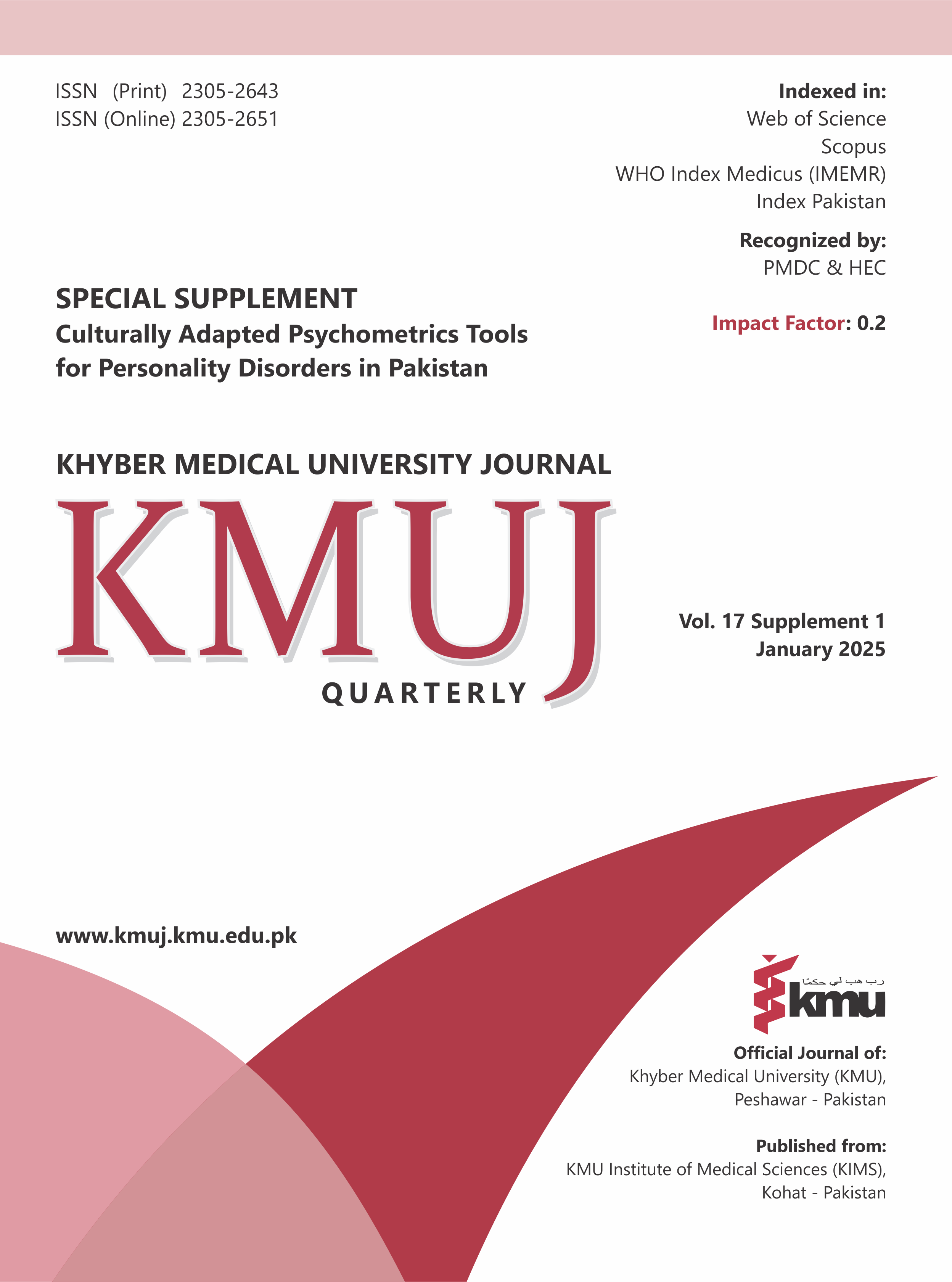Development and validation of an indigenous Urdu measure for Schizoid personality disorder in adults
Main Article Content
Abstract
Objective: To develop and validate an indigenous Urdu scale for assessing Schizoid personality disorder in adults and to evaluate its psychometric properties.
Methods: This cross-sectional study, conducted between February and June 2019, utilized Diagnostic and Statistical Manual of Mental Disorders-5 criteria, existing literature, and clinical observations to develop a 63-item pool. After expert review and pilot testing, a 43-item scale was administered to 234 participants (123 males, 111 females) aged 18 to 60 years, drawn from both clinical and non-clinical populations in Gujrat, Pakistan. The scale underwent exploratory factor analysis (EFA) and confirmatory factor analysis (CFA) to refine the items, resulting in a 14-item measure with three subscales: solitariness, emotional coldness, and indifference to praise. The psychometric properties, including reliability and convergent validity, were assessed using Cronbach's alpha and the University of California, Los Angeles (UCLA) Loneliness Scale (Version 3).
Results: The Indigenous Schizoid Personality Disorder Scale (SPDS) exhibited robust psychometric properties. EFA identified four factors, with three confirmed through CFA. The scale demonstrated excellent model fit indices (CMIN/DF=1.765, CFI=0.955, RMSEA=0.057). Cronbach's alpha for the total scale was 0.887, with subscale reliabilities ranging from 0.768 to 0.852. Convergent validity was supported by a significant positive correlation (r=0.452, p<0.01) with the UCLA Loneliness Scale.
Conclusion: The 14-item Indigenous SPDS demonstrated strong psychometric properties, providing a culturally relevant and reliable tool for assessing schizoid personality disorder in Urdu-speaking populations. This scale holds significant value for researchers, clinical psychologists, students, and mental health practitioners, enhancing its utility across diverse clinical and non-clinical settings.
Article Details

This work is licensed under a Creative Commons Attribution 4.0 International License.
Work published in KMUJ is licensed under a
Creative Commons Attribution 4.0 License
Authors are permitted and encouraged to post their work online (e.g., in institutional repositories or on their website) prior to and during the submission process, as it can lead to productive exchanges, as well as earlier and greater citation of published work.
(e.g., in institutional repositories or on their website) prior to and during the submission process, as it can lead to productive exchanges, as well as earlier and greater citation of published work.
References
1. Loch AA. Schizophrenia, not a psychotic disorder: bleuler revisited. Front Psychiatry 2019;10:328. https://doi.org/10.3389/fpsyt.2019.00328
2. Millon T, Davis RD. Schizoid personality disorders: The asocial pattern. In, Millon T, Davis RD (eds), Disorders of personality DSM-IV TM and beyond. 1996. Wiley & Sons, New York, USA.
3. Sanchez-Roige S, Gray JC, MacKillop J, Chen CH, Palmer AA. The genetics of human personality. Genes Brain Behav 2018;17(3):e12439. https://doi.org/10.1111/gbb.12439
4. Gescher DM, Kahl KG, Hillemacher T, Frieling H, Kuhn J, Frodl T. Epigenetics in personality disorders: today's insights. Front Psychiatry 2018;9:579. https://doi.org/10.3389/fpsyt.2018.00579
5. Yang M, Ullrich S, Roberts A, Coid J. Childhood institutional care and personality disorder traits in adulthood: findings from the British national surveys of psychiatric morbidity. Am J Orthopsychiatry 2007;77(1):67-75. https://doi.org/10.1037/0002-9432.77.1.67
6. Beck AT, Freeman AT & Associates. Cognitive therapy of personality disorders. 2004. Guilford Press, New York, USA.
7. American Psychiatric Association. Diagnostic statistical manual for mental disorders. 5th ed. Arlington, V.A: American Psychiatric Publications; 2013.
8. Blagov P, Ortigo KM. Schizoid Personality Disorder and Gender. In, Nadal KL, The SAGE Encyclopaedia of Psychology and Gender. 2017:1442-4. SAGE Publications Inc, Thousand Oaks, California. https://doi.org/10.4135/9781483384269
9. Tay L, Jebb A. Scale Development. In: Rogelberg S, ed. The SAGE Encyclopaedia of Industrial and Organizational Psychology. 2nd ed. 2017. SAGE Publications Inc, Thousand Oaks, California.
10. Rahn M. Factor analysis: a short introduction, part 5–dropping unimportant variables from your analysis 2018. [Accessed on: July 20, 2019]. Available from URL: https://www.theanalysisfactor.com/fa ctor-analysis-5
11. Worthington RL, Whittaker TA. Scale development research: a content analysis and recommendations for best practices. Couns Psychol 2006;34(6):806-38. http://dx.doi.org/10.1177/0011000006288127
12. Miller-Carpenter S. Ten steps in scale development and reporting: a guide for researchers. Commun Methods Meas 2018;12(1):25-44. http://dx.doi.org/10.1080/19312458.2017.1396583
13. Russell DW. UCLA Loneliness Scale (Version 3): reliability, validity, and factor structure. J Pers Assess 1996;66(1):20-40. https://doi.org/10.1207/s15327752jpa6601_2
14. American Psychiatric Association. Diagnostic and statistical manual of mental disorders (5th ed., text rev.). 2022. Arlington, V.A: American Psychiatric Publications https://doi.org/10.1176/appi.books.9780890425787
15. Tabachnick BG, Fidell LS. Using multivariate statistics. 5th ed. 2007. 2007.: Pearson Education Inc. Boston, New York, USA.
16. Hooper D, Coughlan J, Mullen M. Structural equation modelling: guidelines for determining model fit. Electron J Bus Res Methods 2008;6(1):53-60.
17. Hinkle DE, Wiersma W, Jurs SG. Applied Statistics for the Behavioral Sciences. 5th ed. 2003. Houghton Mifflin, Boston.
